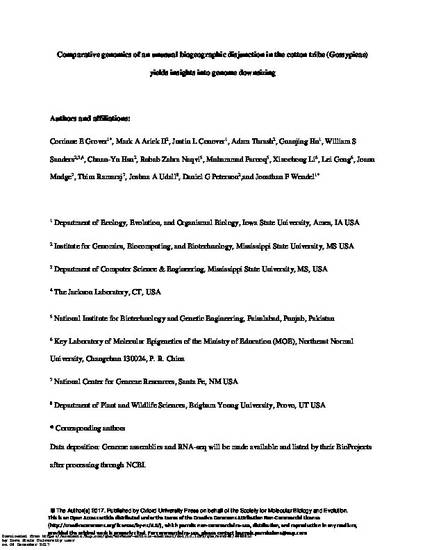
Long-distance insular dispersal is associated with divergence and speciation because of founder effects and strong genetic drift. The cotton tribe (Gossypieae) has experienced multiple trans-oceanic dispersals, generating an aggregate geographic range that encompasses much of the tropics and subtropics worldwide. Two genera in the Gossypieae, Kokia and Gossypioides, exhibit a remarkable geographic disjunction, being restricted to the Hawaiian Islands and Madagascar/East Africa, respectively. We assembled and use de novo genome sequences to address questions regarding the divergence of these two genera from each other and from their sister-group, Gossypium. In addition, we explore processes underlying the genome downsizing that characterizes Kokia and Gossypioides relative to other genera in the tribe. Using 13,000 gene orthologs and synonymous substitution rates, we show that the two disjuncts last shared a common ancestor about 5 MYA, or half as long ago as their divergence from Gossypium. We report relative stasis in the transposable element fraction. In comparison to Gossypium, there is loss of approximately 30% of the gene content in the two disjunct genera and a history of genome-wide accumulation of deletions. In both genera, there is a genome-wide bias toward deletions over insertions, and the number of gene losses exceeds the number of gains by about two- to four-fold. The genomic analyses presented here elucidate genomic consequences of the demographic and biogeographic history of these closest relatives of Gossypium, and enhance their value as phylogenetic outgroups.
Available at: http://works.bepress.com/jonathan_wendel/66/

This is a manuscript of an article from Grover, Corrinne E., Mark A. Arick, Justin L. Conover, Adam Thrash, Guanjing Hu, William S. Sanders, Hsu Chuan-Yu et al. "Comparative genomics of an unusual biogeographic disjunction in the cotton tribe (Gossypieae) yields insights into genome downsizing." Genome Biology and Evolution. doi: 10.1093/gbe/evx248. Posted with permission.